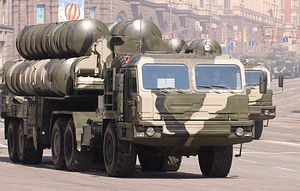Russia has reportedly completed user trials of the 40N6E long-range missile for the S-400 Triumf advanced interceptor-based air defense systems (NATO reporting name: SA-21 Growler), according to a Russian defense industry source.
“The state trials of the 40N6E long-range surface-to-air (SAM) missile for the S-400 system have been completed at the Kapustin Yar practice range,” the source was quoted by TASS news agency as saying on July 3.
“The inter-departmental commission has recognized them as successful and the corresponding certificate has been signed.” The missile “may be accepted for service before the end of summer,” the source added.
The 40N6E SAM has an estimated operational range of 400 kilometers (248.5 miles) and is thought to be capable of reaching a maximum altitude of up to 185 kilometers (607,000 feet). It is reportedly capable of exo-atmospheric interception of intermediate-range ballistic missile warheads in their terminal phase. The first pre-production batch of the missile was manufactured in 2013. According to the Russian Ministry of Defense, a first successful interception test took place in 2015.
There has been speculation that Russia, following the induction of the missile, will sell the 40N6E to China and possibly India. China took delivery of its first out of two planned S-400 regiments (there may be follow-up orders) earlier this year, whereas India and Russia are still locked in negotiations over the procurement of five S-400 regiments notwithstanding possible U.S. sanctions.
“The standard S-400 battery consists of four transporter erector launchers (TELs), four launch tubes per TEL, in addition to target acquisition and engagement (fire control) radar systems and a command post. (With an additional fire control radar system, a battery can consist of up to 12 TELs.),” I explained elsewhere. “Two batteries make up a S-400 battalion (also known as a S-400 division), whereas a S-400 regiment consists of two battalions.”
Next to the 40N6E, the S-400 can be armed with a host of different missiles as I explained previously:
In comparison to its predecessor, the S-300, the S-400 air defense system features an improved radar system and updated software; it can purportedly fire four new types of surface-to-air (SAM) missiles in addition to the S-300’s 48N6E, a vertical tube launched, solid fuel, single stage SAM with an estimated range of 150 kilometers (93 miles), and the improved 48N6E2 missile with a reported range of 195 kilometers (121 miles).
(…)
The S-400 is also armed with an improved variant of the 48N6E2 with an alleged range of 250 kilometers (160 miles). The air defense system can also fire two additional missiles, the 9M96E and 9M96E2 with respective ranges of 40 km (25 miles) and 120 km (75 miles). Improved S-300 air defense systems such as the S-300PMU-2 Favorite … can purportedly also fire the 9M96E and 9M96E2.
The Russian military currently operates 20 S-400 regiments (23 according to the Russian Ministry of Defense). By 2020, Russia hopes to have 28 S-400 regiments or 56 battalions. Earlier this year, the Russia has reinforced the air defenses of its naval bases in the Russian Far East by stationing additional S-400 SAM batteries near Vladivostok. “The deployment of additional S-400 air defense systems correlates with the need to protect Russia’s slowly expanding naval presence in the Asia-Pacific region,” I noted. “In 2018, the Russian Navy’s second biggest fleet is expected to receive ten new warships including new nuclear-powered ballistic missile submarines.”































